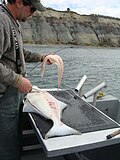Halibut
Halibut is a common name for two flatfish in the genus Hippoglossus from the family of right-eye flounders and, in some regions, and less commonly, other species of large flatfish.
The fish are demersal fish that live in the North Pacific and the North Atlantic oceans. They are noted for their high yield of white, firm, dense and sweet flesh.
Species[edit]
There are two species of Halibut, the Atlantic Halibut (Hippoglossus hippoglossus) and the Pacific Halibut (Hippoglossus stenolepis).
Description[edit]
Halibut are dark brown on the top side with an off-white underbelly and have very small scales invisible to the naked eye embedded in their skin. Halibut are symmetrical at birth with one eye on each side of the head. Then, about six months later, during larval metamorphosis one eye migrates to the other side of the head. The eyes are permanently set once the skull is fully ossified.
Diet[edit]
Halibut feed on almost any fish or animal that they can fit into their mouths. Generally, their diet consists of fish such as pollock, sablefish, and rockfish.
Fishing[edit]
Halibut are among the largest teleost fishes in the world. Halibut are demersal, living on or near the bottom of the water and prefer water temperatures ranging from 3 to 8 degrees Celsius (37.4 to 46.4 degrees Fahrenheit). Halibut are strong swimmers and are able to migrate long distances. Halibut size is not age-specific but tends to be a function of environment and diet.
Health Benefits[edit]
Halibut is low in saturated fat and sodium and is a very good source of high-quality protein, selenium, and phosphorous. It is also a good source of vitamins B6 and B12, both of which are important for cardiovascular health.
See Also[edit]
Ad. Transform your life with W8MD's Budget GLP-1 injections from $75


W8MD offers a medical weight loss program to lose weight in Philadelphia. Our physician-supervised medical weight loss provides:
- Weight loss injections in NYC (generic and brand names):
- Zepbound / Mounjaro, Wegovy / Ozempic, Saxenda
- Most insurances accepted or discounted self-pay rates. We will obtain insurance prior authorizations if needed.
- Generic GLP1 weight loss injections from $75 for the starting dose.
- Also offer prescription weight loss medications including Phentermine, Qsymia, Diethylpropion, Contrave etc.
NYC weight loss doctor appointmentsNYC weight loss doctor appointments
Start your NYC weight loss journey today at our NYC medical weight loss and Philadelphia medical weight loss clinics.
- Call 718-946-5500 to lose weight in NYC or for medical weight loss in Philadelphia 215-676-2334.
- Tags:NYC medical weight loss, Philadelphia lose weight Zepbound NYC, Budget GLP1 weight loss injections, Wegovy Philadelphia, Wegovy NYC, Philadelphia medical weight loss, Brookly weight loss and Wegovy NYC
|
WikiMD's Wellness Encyclopedia |
| Let Food Be Thy Medicine Medicine Thy Food - Hippocrates |
Medical Disclaimer: WikiMD is not a substitute for professional medical advice. The information on WikiMD is provided as an information resource only, may be incorrect, outdated or misleading, and is not to be used or relied on for any diagnostic or treatment purposes. Please consult your health care provider before making any healthcare decisions or for guidance about a specific medical condition. WikiMD expressly disclaims responsibility, and shall have no liability, for any damages, loss, injury, or liability whatsoever suffered as a result of your reliance on the information contained in this site. By visiting this site you agree to the foregoing terms and conditions, which may from time to time be changed or supplemented by WikiMD. If you do not agree to the foregoing terms and conditions, you should not enter or use this site. See full disclaimer.
Credits:Most images are courtesy of Wikimedia commons, and templates, categories Wikipedia, licensed under CC BY SA or similar.
Translate this page: - East Asian
中文,
日本,
한국어,
South Asian
हिन्दी,
தமிழ்,
తెలుగు,
Urdu,
ಕನ್ನಡ,
Southeast Asian
Indonesian,
Vietnamese,
Thai,
မြန်မာဘာသာ,
বাংলা
European
español,
Deutsch,
français,
Greek,
português do Brasil,
polski,
română,
русский,
Nederlands,
norsk,
svenska,
suomi,
Italian
Middle Eastern & African
عربى,
Turkish,
Persian,
Hebrew,
Afrikaans,
isiZulu,
Kiswahili,
Other
Bulgarian,
Hungarian,
Czech,
Swedish,
മലയാളം,
मराठी,
ਪੰਜਾਬੀ,
ગુજરાતી,
Portuguese,
Ukrainian









